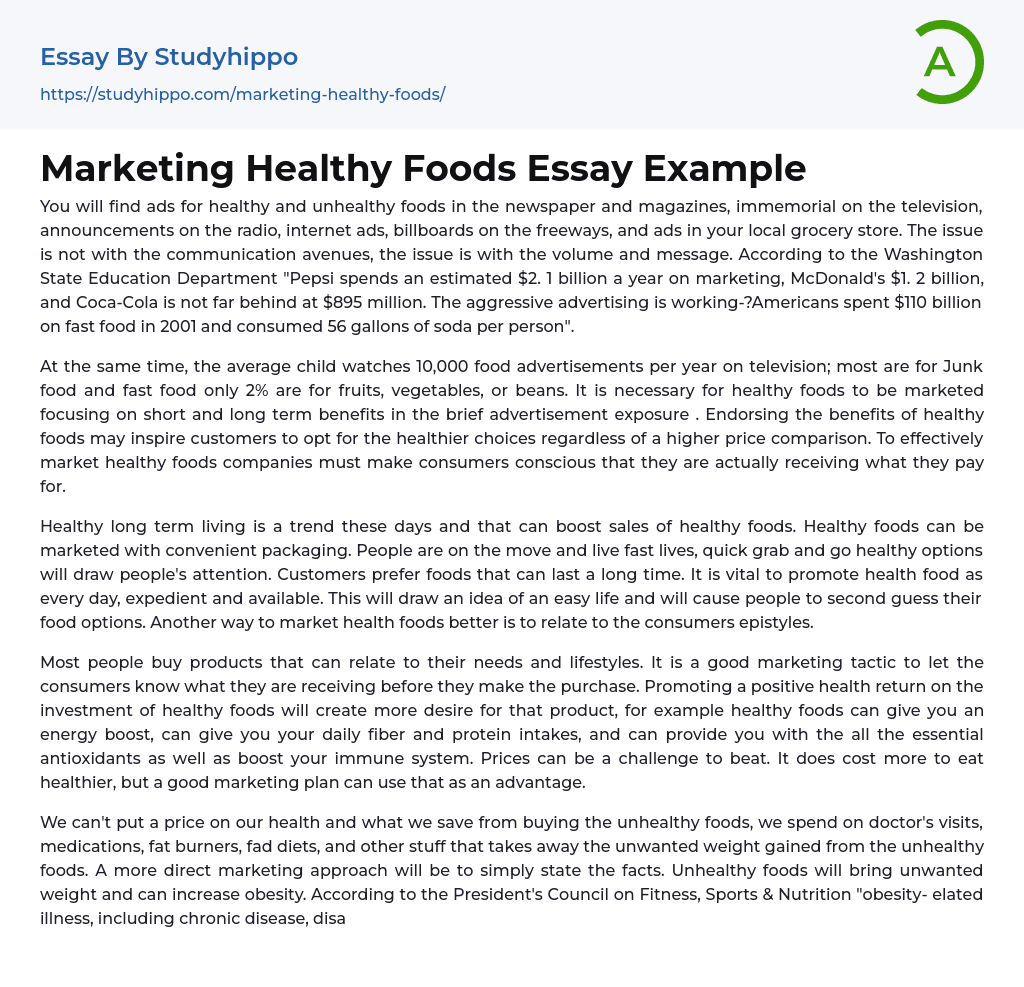Advertisements promoting both healthy and unhealthy foods are widespread across various media channels such as newspapers, magazines, television, radio, the internet, billboards, and grocery stores. The concern lies not in the different communication channels but rather in the high volume and messaging of these ads.
According to the Washington State Education Department, Pepsi spends about $2.1 billion annually on marketing, followed by McDonald's at $1.2 billion and Coca-Cola at $895 million. These aggressive advertising tactics have proven successful as Americans spent an astonishing $110 billion on fast food in 2001 and consumed an average of 56 gallons of soda per person.
Simultaneously, children are exposed to approximately 10,000 food advertisements on TV each year. Unfortunately, most of these ads promote junk food and fast food while only a mere 2% advertise fruits, vegetables or beans. Therefore, it is cruc
...ial to market healthy foods by highlighting their short- and long-term benefits through brief advertisements.
By emphasizing the advantages of nutritious foods despite potentially higher prices compared to unhealthy options companies may encourage customers to choose healthier alternatives; thus it is worth investing in nutritious foods.
Through emphasizing the value for money, convenience, and health benefits of healthy foods, companies can effectively market these products to a wide range of customers. Furthermore, by highlighting the energy boost, fiber and protein content, antioxidants, and immune system support that come with consuming healthy foods, marketers can further increase consumers' desire for these products. Despite potential price challenges due to the higher cost of healthier options, a well-executed marketing strategy can utilize this as an advantage by emphasizing the importance of investing in one's health. While avoiding unhealthy foods ma
initially seem like savings, it often results in expenses on medical visits, medications, and other weight loss methods caused by those foods. According to the President's Council on Fitness, Sports & Nutrition, unhealthy foods lead to weight gain and contribute to obesity. This leads to obesity-related illnesses such as chronic disease disability and death which incur an annual cost of approximately $190 billion. Projections indicate that by 2018 obesity will account for 21 percent of total healthcare costs in the U.S., amounting to $344 billion per year. On average, medical costs for obese individuals are $1,429 higher than those with a normal weight—a roughly 42% increase. The annual cost for being overweight is $524 for women and $432 for men;Being obese not only incurs higher costs for women ($4,879) and men ($2,646), but it also presents a threat to national security due to the increasing number of young Americans who are too overweight to join the military. Around 27% of them fall into this category, highlighting the need to change eating habits for both financial gain and overall health in America.
- Food Safety essays
- Food Security essays
- Beverages essays
- Cuisines essays
- Dairy essays
- Desserts essays
- Fast Food essays
- Bread essays
- Meal essays
- Meat essays
- Organic Food essays
- Rice essays
- Sugar essays
- Taste essays
- Beef essays
- Coconut essays
- Crowd essays
- Dinner essays
- Juice essays
- Sainsbury essays
- Cooking essays
- Ginger essays
- Oreo essays
- Drink essays
- Beer essays
- Wine essays
- Coffee essays
- Tea essays
- Cake essays
- Hamburger essays
- Ice Cream essays
- Burger essays
- Pizza essays
- Fruit essays
- Lemon essays
- Food Waste essays
- Favorite Food essays
- Alcoholic essays
- Soft Drinks essays
- Cookie essays
- Starch essays
- Yeast essays
- Cola essays
- Pizza Hut essays
- snack foods essays
- chips essays
- Biscuit essays
- Brewing essays
- Brewery essays
- Anatomy and Physiology essays




